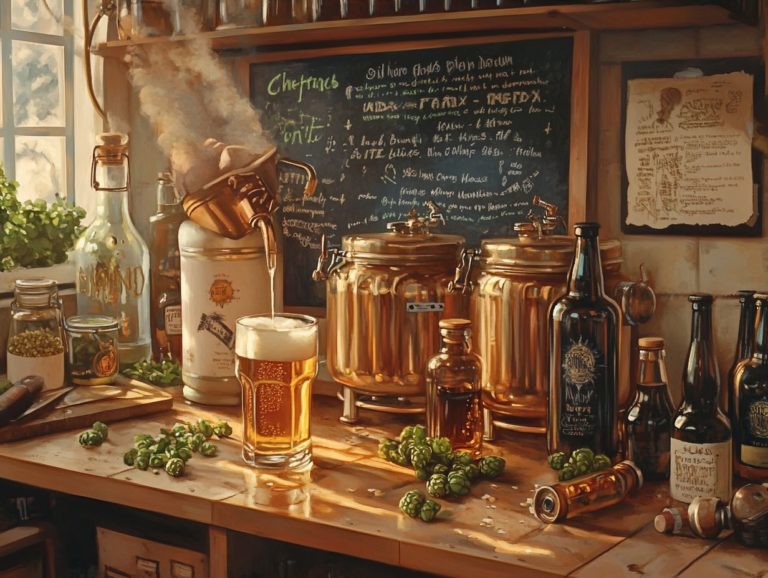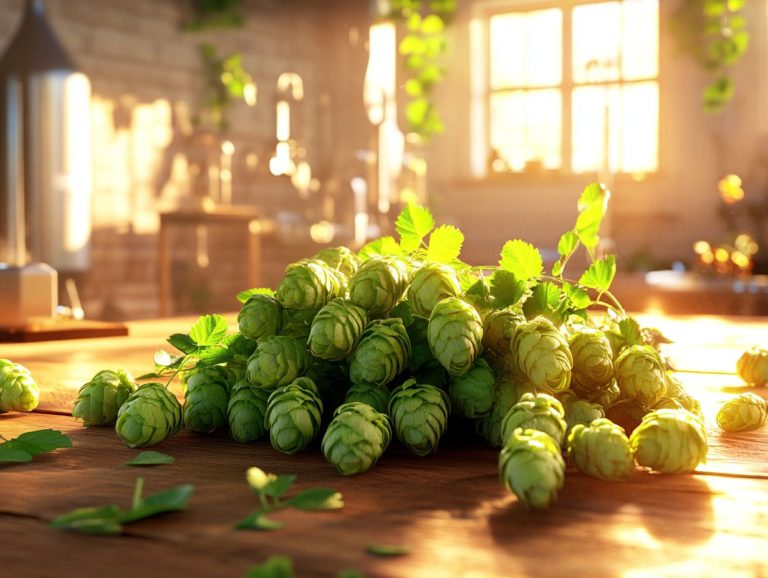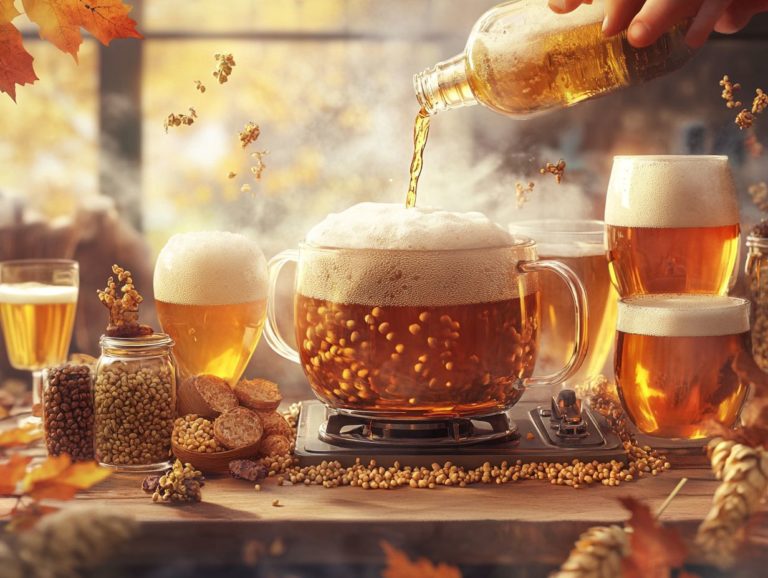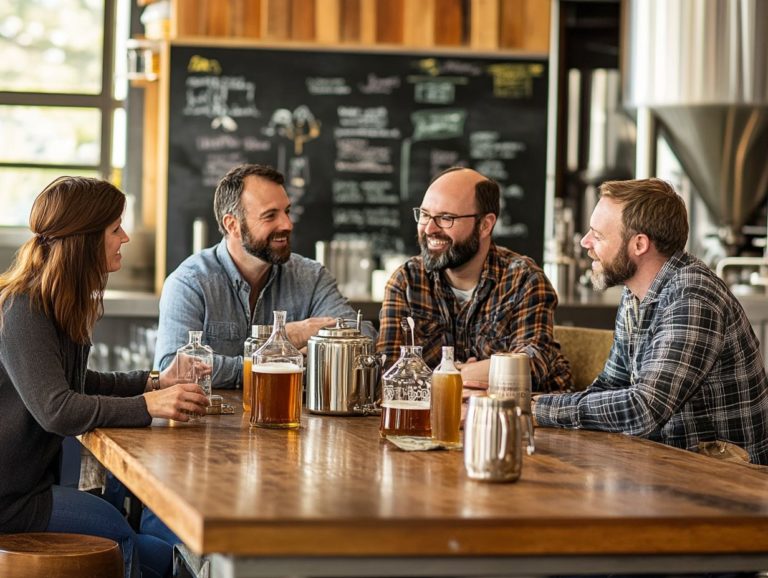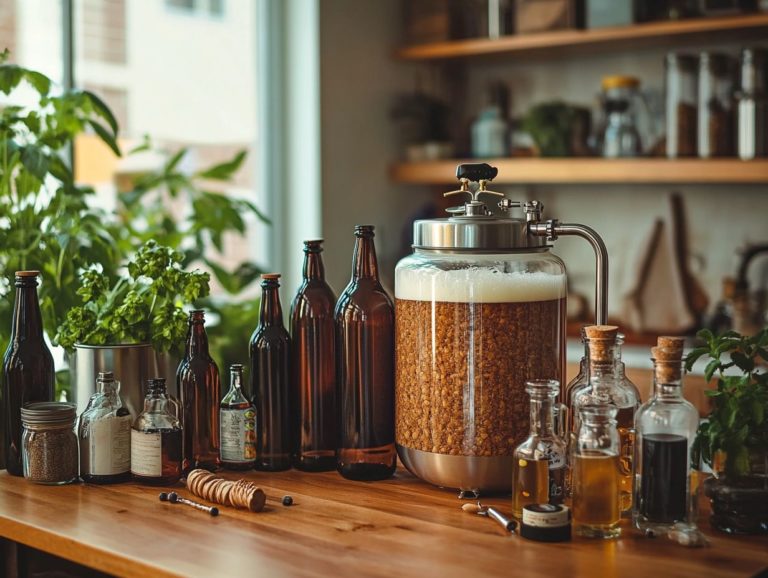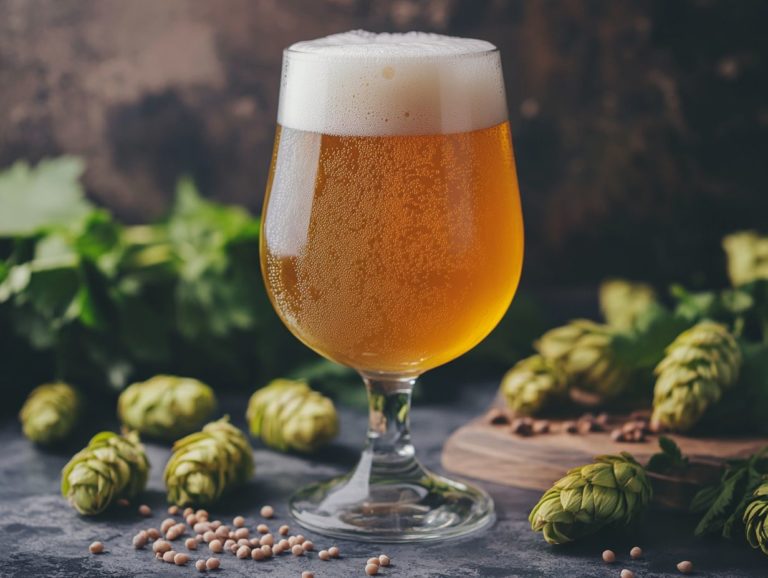What Is the Role of Hops in Brewing?
Hops are essential in brewing, providing far more than just a touch of bitterness. These vibrant green flowers elevate the flavor and aroma of beer while also serving as a natural preservative due to their unique lupulin glands.
In this exploration, you will delve into the multifaceted functions of hops, uncovering their bitterness, flavor notes, and aromatic contributions. You will also explore how hops interact with other beer ingredients like barley, yeast, and water, which are critical to the brewing cycle.
Join us on an exciting journey into the vibrant world of hops!
Contents
- Key Takeaways:
- Why Are Hops Used in Brewing?
- Types of Hops
- How Are Hops Grown and Harvested?
- How Do Hops Contribute to the Brewing Process?
- Adding Hops to the Boiling Wort
- 2. Dry Hopping
- Hops Varieties and Their Characteristics
- 1. Citra Hops
- 2. Cascade Hops
- 3. Hallertau Hops
- 4. Saaz Hops
- 5. Fuggle Hops
- Frequently Asked Questions
- What Is the Role of Hops in Brewing?
- How do hops contribute to the flavor of beer?
- What about the aroma of beer?
- Do hops have any other benefits in brewing?
- What types of hops are typically used in brewing?
- How much hops should be used in brewing?
Key Takeaways:
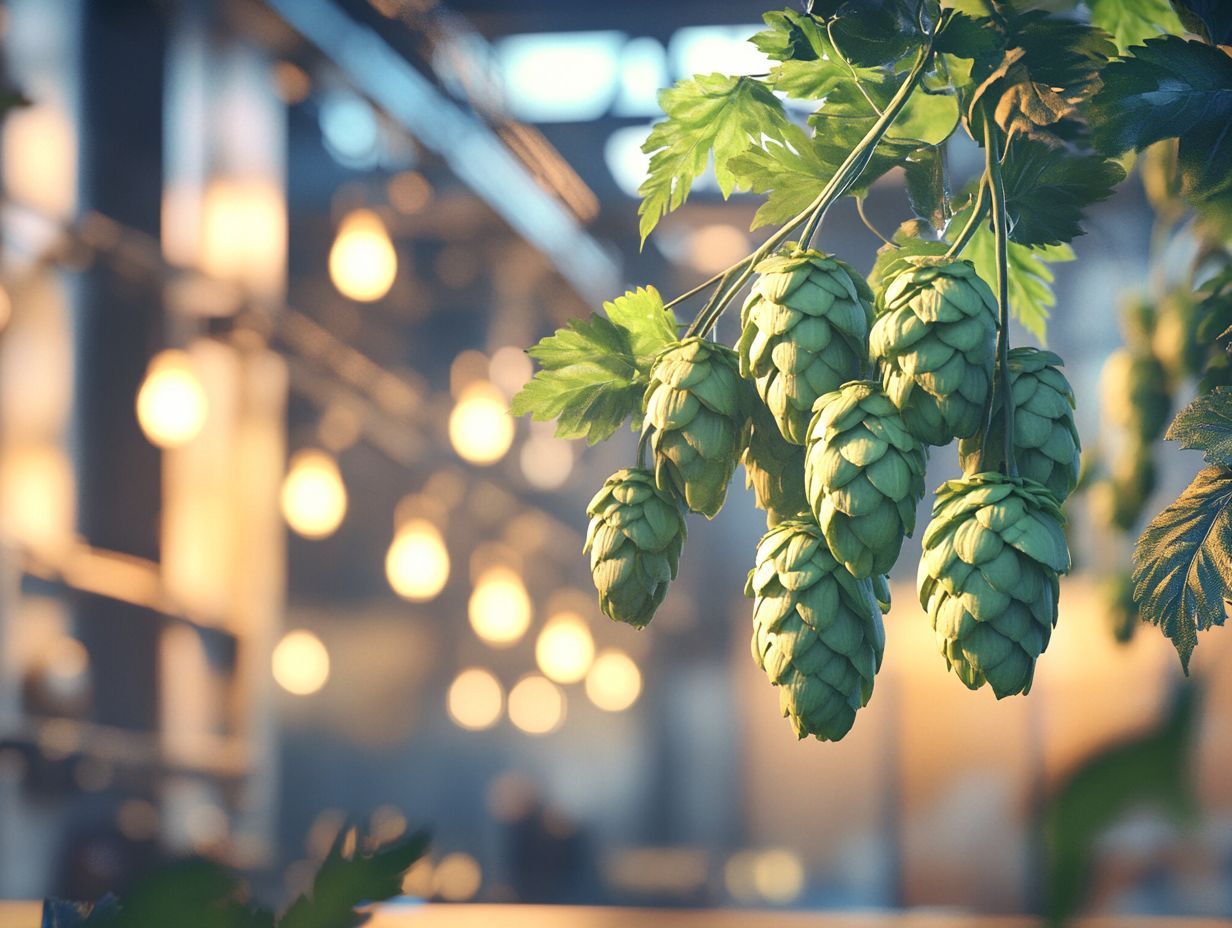
- Hops play a crucial role in the brewing process, serving as a bittering, flavoring, and aroma agent.
- Hops are typically grown in cool, moist climates, such as the Pacific Northwest, and are harvested by hand or machine.
- There are three main types of hops: bittering, aroma, and dual-purpose, each with their unique characteristics and uses in brewing, greatly influencing various beer styles.
Why Are Hops Used in Brewing?
Hops, or Humulus lupulus, are an essential component of the brewing process, tracing their roots back to ancient beer-making traditions in Germany. They have evolved into the rich tapestry of craft beer styles we enjoy today.
They do more than just add bitterness to balance the malt’s sweetness, as quantified by International Bittering Units (IBUs). Hops also play a pivotal role in shaping flavor profiles and aroma characteristics, particularly in hoppy varieties like IPAs and lager beers.
With their distinctive alpha acids and resin oils, hops can unleash a delightful array of flavor notes, from herbal undertones to tropical fruit bursts. This enriches your overall beer tasting experience and contributes to the unique flavors of various beer recipes.
1. Bittering Agent
Bittering hops are essential in brewing, providing the necessary bitterness to perfectly balance the sweetness of malt, often measured in International Bittering Units (IBUs). These hops define the flavor profile of various beer styles, such as India Pale Ales (IPAs) and lagers.
The right level of bitterness can truly elevate or undermine the final taste. The alpha acids found in these hops, particularly in varieties like Cascade and Centennial, deliver that sharp, resinous bitterness that craft beer enthusiasts crave.
When brewing IPAs, you will likely reach for high-alpha hop varieties to create a bold and assertive flavor. For lagers, opting for more subtle hop selections like Hallertau can provide a refined bitterness that complements their crisp character.
The careful selection and timing of these hops during the brewing process can significantly shape your beer’s overall perception, allowing for a harmonious balance between bitterness and sweetness that makes each sip a delight.
2. Flavoring Agent
Beyond imparting bitterness, hops serve as a remarkable flavoring agent, adding distinct profiles that elevate the essence of hoppy beers and various brewing recipes. Each hop variety contributes its own unique character to the brewing process.
For instance, Cascade hops are celebrated for their floral and citrus notes, often shining through in beloved American Pale Ales like Sierra Nevada Pale Ale. On the other hand, Citra hops deliver a vibrant burst of tropical fruit flavors, earning them a place of honor in many IPAs, such as Founders All Day IPA.
The influence of these hops extends beyond mere aroma and taste; they also play a crucial role in the fermentation process. Here, specific yeast strains interact with hop compounds, resulting in well-rounded flavor profiles.
This intricate dance illustrates just how vital the selection of hops is in crafting beers that cater to a wide range of palates, from ales to lagers.
Aroma Agents
Aroma hops are essential to your brewing endeavors. They deliver captivating hop aromas that shape the experience of hop-forward beers. Techniques like dry hopping a method of adding hops during fermentation instead of boiling and the use of fresh hops are your secret weapons in this aromatic journey, greatly enhancing the beer tasting experience.
These hops also add layers of complexity to a diverse array of beer styles. They infuse everything from the zesty brightness of IPAs to the delicate floral notes found in pale ales. By employing the dry hopping technique, you create a more concentrated aroma, elevating the beer s olfactory allure while keeping excessive bitterness at bay.
When you utilize fresh hop varieties, often harvested at their peak, you invite vibrant and nuanced flavors that evolve throughout the brewing process. This meticulous attention to detail ensures that every sip delivers an aromatic explosion, enticing drinkers to return for more. Plus, it adheres to the German beer purity law for quality and authenticity.
Types of Hops
Hops are categorized into several distinct types, each defined by their characteristics and specific roles in brewing. These include:
- Bittering Hops: These hops are used primarily to add bitterness to the beer, balancing out the sweetness of the malt.
- Aroma Hops: These hops are added for their aromatic properties and are typically used late in the brewing process.
- Dual-Purpose Hops: These hops can be used for both bitterness and aroma, offering versatility in brewing.
With each variety offering its unique contributions that enhance the diverse styles of beer, don t miss out on the incredible flavors these hops can bring to your brewing!
How Are Hops Grown and Harvested?
Hops thrive best in the Pacific Northwest, particularly in regions like Yakima. The unique interplay of soil quality and climate significantly influences the quality and yield of different hop varieties during harvest.
The region s specific growing conditions create an ideal environment for cultivating hops. This ensures that each variety reaches its full potential.
1. Growing Conditions
Cultivating hops demands the right growing conditions, including well-drained soil and a climate that nurtures the diverse varieties of hops. This process is known as hop cultivation.
For successful hop cultivation, moderate climates are your best friend. Temperatures ideally range from 60 F to 70 F throughout the growing season. Soil with a pH level between 6.0 and 7.0 promotes nutrient uptake, which is crucial for robust vine development.
Regions like the Pacific Northwest have become synonymous with hop farming, thanks to their unique geographical features. Ample rainfall and fertile volcanic soil create an ideal environment for hop cultivation. These microclimates, combined with long summer days, significantly enhance the quality and flavor of the hops produced, making them a favorite among brewing enthusiasts.
2. Harvesting Process
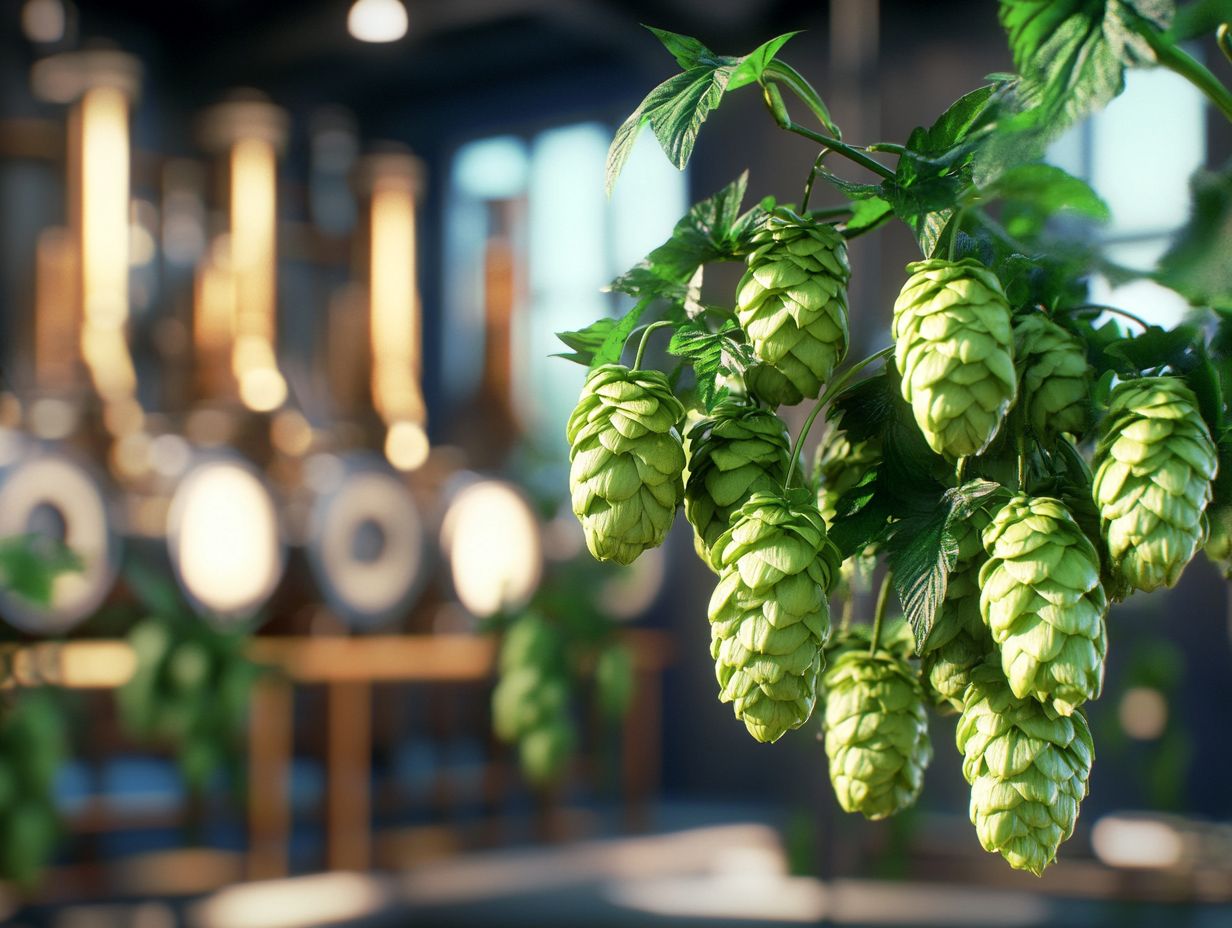
The harvesting process of hops is crucial as it significantly influences both the quality and yield of hop varieties. This usually takes place from late summer to early fall. During this period, closely observe your plants to pinpoint the ideal harvest window, determined by the cones achieving peak oil concentration and aromatic profile.
To efficiently collect the hops while minimizing damage, various methods come into play. These include hand-picking and mechanical harvesting. You might leverage advanced technologies, such as automated hop-picking machines, to streamline the process without sacrificing quality.
Handle the delicate hop cones with care to avoid crushing or bruising them. Any mishandling can lead to the deterioration of their unique flavors and aromas, impacting the quality of the final brew you re aiming to perfect. This emphasizes the importance of proper hop selection in the brewing process.
Bittering Hops
Bittering hops are carefully selected for their high alpha acids, making them perfect for adding necessary bitterness to a variety of beer styles, including IPAs and pilsners. Their bittering qualities are essential in achieving a balanced flavor profile.
Varieties like Magnum and Chinook are celebrated for their clean and crisp bitterness. These hops are commonly found in West Coast IPAs that prioritize hop-forward flavors.
On the other hand, varieties such as Hallertauer and Saaz are often featured in German pilsners. They offer a more nuanced bitterness that beautifully complements the malty backbone, enhancing the overall drinking experience.
Breweries love to experiment with these hops, leading to innovative and exciting recipes that highlight their unique characteristics. Examples include Sierra Nevada Pale Ale and Pilsner Urquell. These brews showcase how bittering hops contribute to the essence of beer, demonstrating their preserving qualities and essential roles for craft brewers.
Aroma Hops
Aroma hops are truly the gems of the brewing world. They are celebrated for their distinct fragrances and are often added toward the end of the brewing process to elevate the flavor profiles of various beer styles, particularly hoppy beers.
These hops bestow an impressive array of scents, including the refreshing, citrusy brightness of Citra and Amarillo, alongside the lush, tropical notes found in Mosaic and Galaxy. Selecting these aroma hops enriches the overall sensory experience of the beer and gives you the power to craft compelling narratives through your creations.
Imagine a New England IPA that highlights the juicy, fruity character of Citra hops, resulting in a vibrant and aromatic profile. In contrast, a Belgian Witbier may embrace the spicy, floral essence of Saaz or Hallertau hops. This weave together layers of complexity invites you to savor each delightful sip, showcasing the diverse hop characteristics.
Dual-Purpose Hops
Dual-purpose hops bring both bittering and aromatic qualities to the table, allowing you to craft complex flavor profiles across many beer styles.
With these hops in your toolkit, you can simplify your ingredient list by using just one variety to achieve both the desired bitterness and enticing fragrance in your brews. Take the Cascade hop, for instance; it s renowned for its floral and citrus notes while delivering the perfect level of bitterness for IPAs.
Then there s the Citra hop, which melds tropical fruit aromas with a balanced bitterness, earning its place as a favorite in Pale Ales and Double IPAs.
Incorporating dual-purpose hops like these into your brewing process allows you to experiment with diverse techniques and recipes, crafting unique interpretations while ensuring high quality and consistency in flavor.
How Do Hops Contribute to the Brewing Process?
Hops are essential in the brewing process. Their addition to the boiling wort is critical, extracting vital oils and alpha acids that contribute significantly to the flavor and preservation of the brew.
Adding Hops to the Boiling Wort
Adding hops to the boiling wort is a pivotal step in brewing. It facilitates the extraction of alpha acids and essential oils that impart both bitterness and flavor to your beer. The timing and type of hops you choose during this stage significantly influence the beer’s final characteristics.
When you make early hop additions, typically at the start of the boil, you’re primarily contributing to the beer’s bitterness. This occurs due to longer exposure to heat, allowing for maximum alpha acid extraction.
On the other hand, adding hops later in the boil or even during fermentation enhances the beer’s aroma and flavor. In this case, those delicate essential oils are less volatile and maintain their integrity better with reduced heat exposure.
Understanding this delicate balance is essential for you as a brewer. You can manipulate hop usage to achieve your desired bitterness levels and craft intricate aroma profiles that showcase the fascinating science behind brewing.
2. Dry Hopping
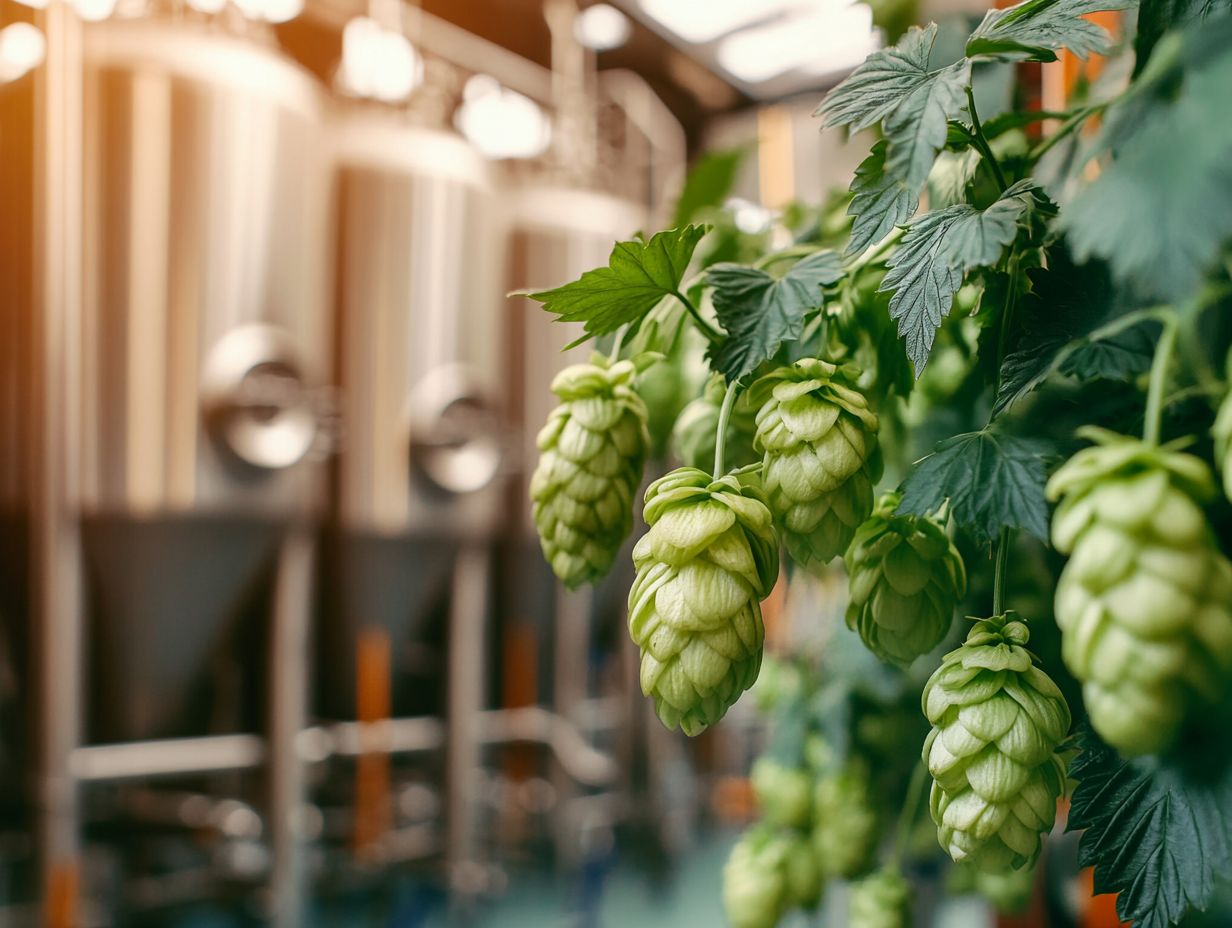
Unlock the secret to elevated flavors in your brews with the masterful technique of dry hopping. This process enhances hop aromas and flavors without adding bitterness by introducing fresh hops during the fermentation stage.
This technique is typically employed after primary fermentation begins. It allows brewers to infuse a vibrant bouquet and a complex array of flavors into the beer.
By thoughtfully selecting the type and timing of hop additions, you can significantly shape the final beer’s aroma and flavor profile.
Take, for example, popular styles like New England IPAs and American Pale Ales. They often burst with intense hop aromas of tropical fruits and citrus, all thanks to skillful dry hopping.
Consider Sierra Nevada s Hazy Little Thing or Dogfish Head s 60 Minute IPA. These examples showcase how this technique can transform an ordinary beer into a captivating aromatic experience that truly delights the senses.
Hops Varieties and Their Characteristics
Explore the fascinating world of hops, where each type brings its own unique flavor to your favorite brews! Hops are available in a captivating array of varieties, each boasting unique characteristics and flavor profiles.
Among the most sought-after are Citra, Simcoe, Cascade, and Centennial, all of which play a pivotal role in shaping the distinct styles of beer they enhance.
1. Citra Hops
Citra hops are celebrated for their vibrant citrus and tropical fruit flavors. They earn a special place in the hearts of craft brewers, especially for IPAs and other hop-forward beers.
Imagine a profile bursting with bright notes of grapefruit and lime. These are complemented by tropical delights like passionfruit and mango.
These aromatic wonders not only elevate the scent but also enhance the taste, delivering a refreshing experience that lingers beautifully on your palate.
Citra hops are versatile. They add a delightful twist to pale ales, double IPAs, and even certain lagers, infusing them with a lively zest that appeals to both novice drinkers and seasoned aficionados alike.
Their remarkable ability to balance bitterness with fruity sweetness creates a unique character that enriches your overall sensory journey, inviting you to dive deeper into the depth and complexity that Citra hops bring to each pour.
2. Cascade Hops
Cascade hops are revered for their enchanting floral and grapefruit aroma. They lend a unique flavor profile to a variety of American ales, particularly pale ales.
Emerging from Oregon in the 1950s, these hops have firmly established themselves as a cornerstone of the craft brewing movement. They demonstrate their versatility and charm for both brewers and enthusiasts alike.
With a moderate bitterness and vibrant citrus notes, they strike the perfect balance across different beer styles, from IPAs to stouts.
Iconic beers like Sierra Nevada Pale Ale and Bell s Two Hearted Ale not only showcase the exceptional quality of Cascade hops but also underscore their significance in shaping the identity of American craft beer.
As craft brewers continue to push boundaries and innovate, the legacy of Cascade hops remains a guiding force in the dynamic world of beer production.
3. Hallertau Hops
Hallertau hops, hailing from Germany, are celebrated for their mild, herbal aroma. They play a pivotal role in upholding the German beer purity law in traditional lager production.
Grown primarily in the picturesque Hallertau region, these hops are cherished for their delicate flavor profile. They impart subtle floral and spicy notes that elevate various German beer styles.
Hallertau hops are essential in the brewing process, particularly in Pilsners and Märzen. Their well-balanced bitterness and gentle aroma enhance the overall sensory experience, complementing rather than overshadowing the other ingredients. For a deeper understanding, check out the role of hops in brewing.
By adhering to rigorous brewing regulations, Hallertau hops ensure both quality and authenticity in German beer craftsmanship, giving brewers the power to create well-rounded beers that pay homage to the country’s rich brewing heritage.
4. Saaz Hops
Saaz hops are a traditional Czech noble hop variety. They offer a delicate, earthy quality essential for crafting classic pilsners and lagers.
Their mild, spicy aroma contributes beautifully to the balanced profile of these beer styles. This combination creates a refreshing and aromatic experience for your palate.
Historically, Saaz hops have been cultivated in the atec (Saaz) region of the Czech Republic for centuries. Their origins trace back to the 13th century, making them one of the oldest hop varieties still in use today.
This rich heritage influences not only the flavor characteristics but also solidifies their esteemed status within the brewing community.
Beyond pilsners, brewers incorporate Saaz hops into various lagers and some wheat beers. Their versatility shines as they complement other flavors without overwhelming them.
5. Fuggle Hops
Fuggle hops are an essential English variety that you ll want to know about. They are known for their mild and earthy aroma, making them a staple in traditional English ales and stouts.
These hops bring subtle complexity to your brews, often revealing delightful hints of woodiness and herbal undertones. When blended with other hop varieties, they complement the maltiness found in many English styles, enhancing your overall drinking experience.
Their low alpha acid content compounds that create bitterness makes them perfect for crafting balanced and sessionable beers. This special trait appeals to everyone, from casual drinkers to seasoned connoisseurs.
The versatility of Fuggle hops keeps them popular among brewers. They truly value the unique flavor profiles Fuggle hops can add to a diverse array of recipes.
Frequently Asked Questions
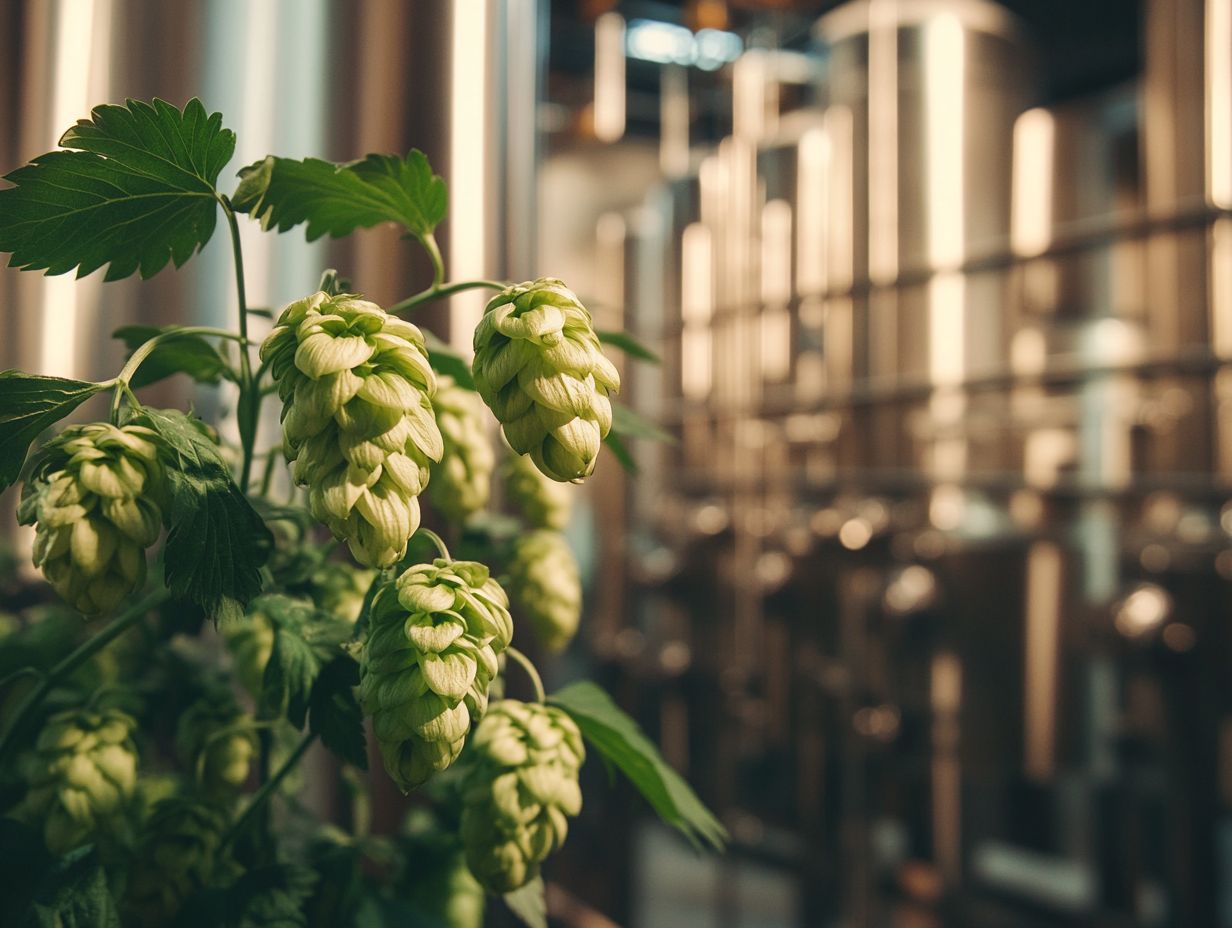
What Is the Role of Hops in Brewing?
Hops are a crucial ingredient in the brewing process. They provide flavor, aroma, and stability to beer.
How do hops contribute to the flavor of beer?
Hops add bitterness to balance the sweetness of malt. They also provide a range of flavors, including citrus, floral, and herbal notes.
What about the aroma of beer?
Hops play a major role in beer aroma. They give it a distinctive and complex smell that can range from fruity to spicy.
Do hops have any other benefits in brewing?
Besides flavor and aroma, hops have natural preservative qualities. They help extend the shelf life of beer.
What types of hops are typically used in brewing?
There are many varieties of hops, each with unique flavor and aroma profiles. Common types include Cascade, Amarillo, and Centennial.
How much hops should be used in brewing?
The amount of hops can vary depending on the desired flavor and aroma. Typically, a brewer will use between 0.5-2 ounces of hops per gallon of beer.

